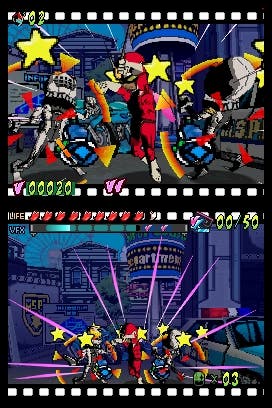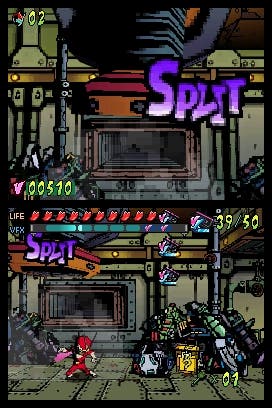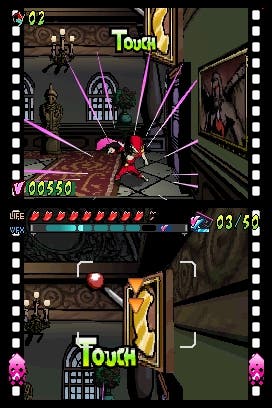Viewtiful Joe: Double Trouble
Touchy.
Viewtiful Joe: Double Trouble thinks about dreams up ways to make it matter in a 2d fighting game what the DS can do and then.
HRM.
Split!
Viewtiful Joe: Double Trouble thinks about dreams up ways to make it matter in a 2d fighting game what the DS can do and then.
> > >
Viewtiful Joe: Double Trouble thinks about what the DS can do and then dreams up ways to make it matter in a 2d fighting game.
For example, you can use the stylus to slide one half of the screen from side to side to align bits of puzzles together. A process a bit like live editing. Genius, eh?
Joe's new adventure is set in the real world, but as long as Silvia trains a camera on him he finds that his VFX powers - the hero abilities that allowed him to slow down time and duck or prance over attacks in the big-console versions - still work. The touch-screen offers a traditional wide-angle 2d side-scrolling view, while the top gives you a close-up of Joe, and the camera is the foil for a range of new VFX powers, like the abovementioned "slide", which are based on the DS's unique capabilities.

"Split" can obviously be used to solve puzzles and rain merry death. "Slide" lets you swap the wide angle for the top-screen close-up by dragging your stylus up one side of the touch-screen to flip them round; this allows you to operate switches and manipulate objects up top directly using the stylus. "Scratch", meanwhile, allows you to rain rubbish down on your enemies by rubbing the screen vigorously while they're stunned.
The new VFX powers have been well worked into the traditional dynamic, which sees you moving from side to side through movie-set-inspired areas fighting groups of enemies. As is tradition, basic enemies attack either high or low - denoted by a little yellow and red skull icon - and you react by holding down or up on the d-pad to avoid it, which stuns them and allows you to start chaining VFX-fuelled attacks together for big scores. More advanced enemies see you slowing down time to deflect or dodge fast-moving bullets, and so on.
You can apply most of them to the game's puzzles, too. You use slow to see the spinning tumblers in a fruit machine and strike when the right ones crop up; you drag a blockage on the top half of the screen so that it's positioned over an otherwise immovable keg of TNT, which you can then uppercut to blow open a hole; you swap the screens round to operate a junkyard magnet with controls like those of an arcade claw-machine. You get the feeling that when everyone was talking smack at E3 that year about how they first saw the DS and went crackers thinking about its potential, Clover Studio just saw it as a way to do the things they'd already been thinking about.

And yet, VJ: Double Trouble somehow manages to feel at once both over-engineered and lacking in depth. Primary control is d-pad for movement, face buttons for jump/kick/punch, shoulders for slow and scratch, and the touch-screen for others, so obviously you end up moving your hands around rather awkwardly to stay in control. Those of you with giant hands or fingernails lengthy enough to reach over and handle the touch-screen without shifting your grip will be fine, but I suffered from the lack of a third arm and a lot of controls to keep in mind.
Rather more worryingly, other than scratch the powers aren't actually that central to combat. Sometimes they do play a part - you can split the screen in the first boss battle, for example, so that you separate the top half of a waste pipe and douse your enemy in green slime - but for the most part battles are just you and two enemies, using slow, basic attacks, and scratch, along with any basic supplementary attacks you've purchased from the between-levels shop.
The original VJ combat was a bit like folding sheets and clothes - you could figure out how to square off a t-shirt and fold a towel just by looking at it, but getting a square sheet snugly round a mattress took time and consideration. Once you'd worked out how to keep combos alive, work in many multiple enemies, and become proficient in dealing with every type of enemy, it was masterful. That's not something you'll really experience here. Things like scratch and slide (which feels a bit like old-Joe's mach speed) play a part, but moving your hand back and forward is a bit awkward, and the stylus input recognition can be hit and miss, which is a pain when you're trying to do things before your VFX meter drains completely.

Technically it's a marvellous achievement - the character models initially seem a bit weaker than their equivalents on your TV, but it's actually more of a sketch-drawn look, and the range of colours and detail in animation is lovely to see on the humble DS. The frame rate sometimes suffers, but it's unmistakably Joe, and fans will enjoy stumbling through sets strewn with little in-jokes. The top-screen close-up, in particular, is a lovely touch, even though you'll probably struggle to drag your eyes in its direction that often.
The problem is that I felt a great deal more admiration for its ingenuity than I had fun playing it. Fans of other VJs will probably find it too easy, won't find as much depth in combat, and may be surprised to learn that it's not really as funny or well-written as the others, while newcomers will initially find the glossed-over combat tutorial confusing, and then may grow weary of the in-jokes and the manner in which the game progresses. The puzzles may use the abilities, but are they actually that ingenious? Not often enough, really. The difficulty thing's particularly weird - VJ is renowned for being har-aaaard. When you kill the first boss in one go, it's a bit jarring - and accessibility doesn't necessarily help it in a broader sense.
It's a shame, because the use of the DS here is as good as it has been anywhere else. Double Trouble is still undeniably a lot of fun - clever ideas, decent puzzles, and so on - but rather like the name, which seems to be struggling to fit the standard jokey Game Name: DS format, the end result isn't quite good enough.








